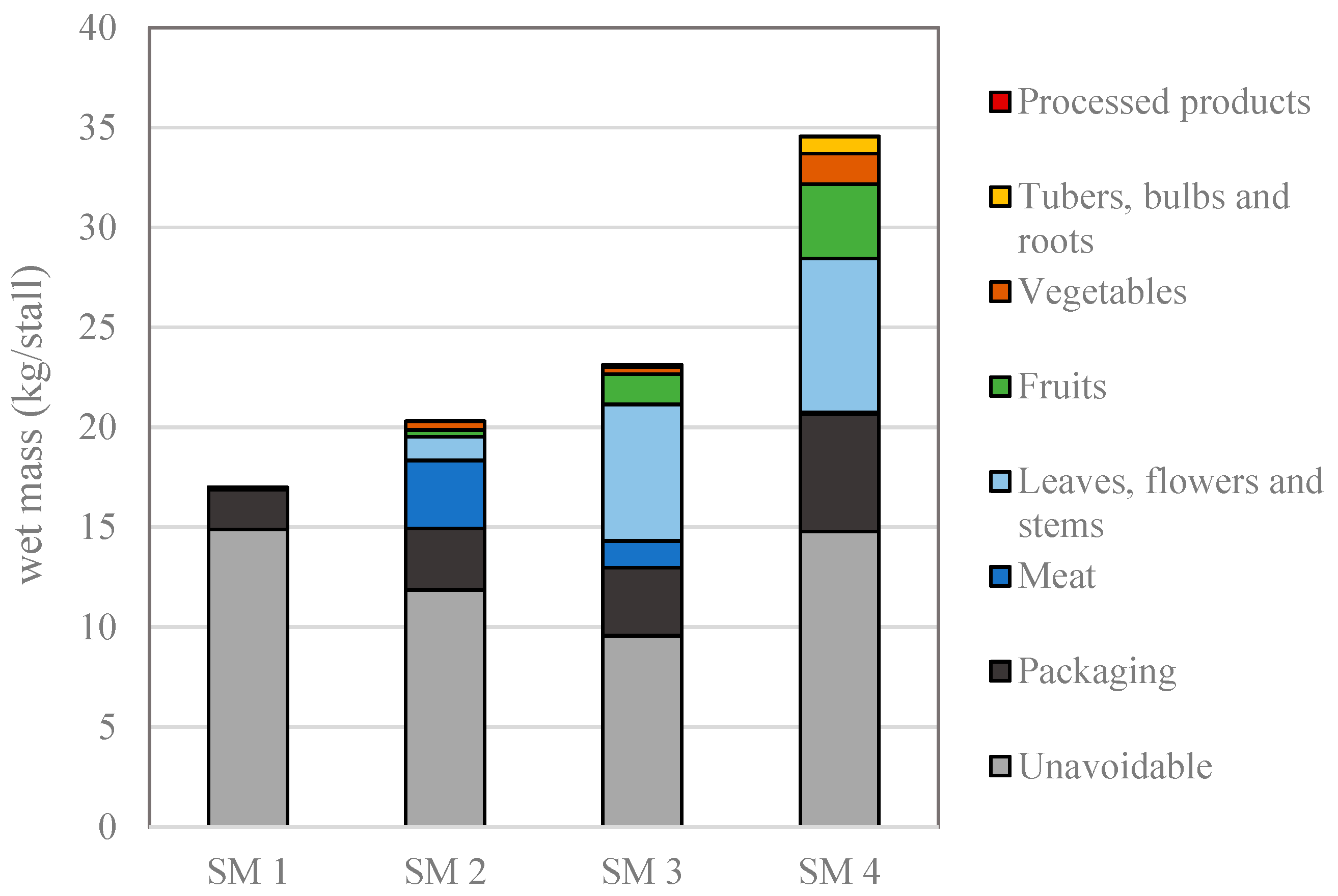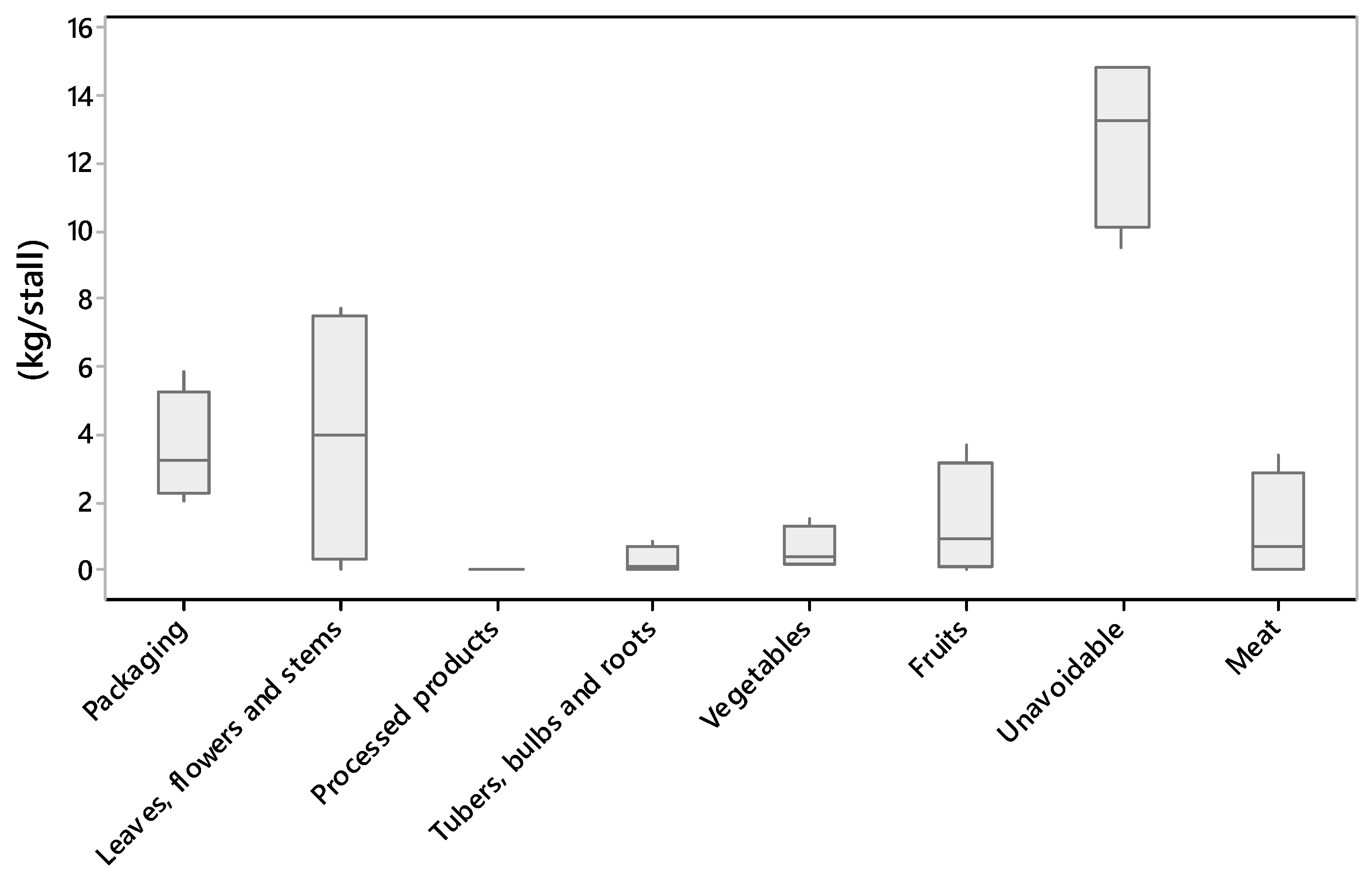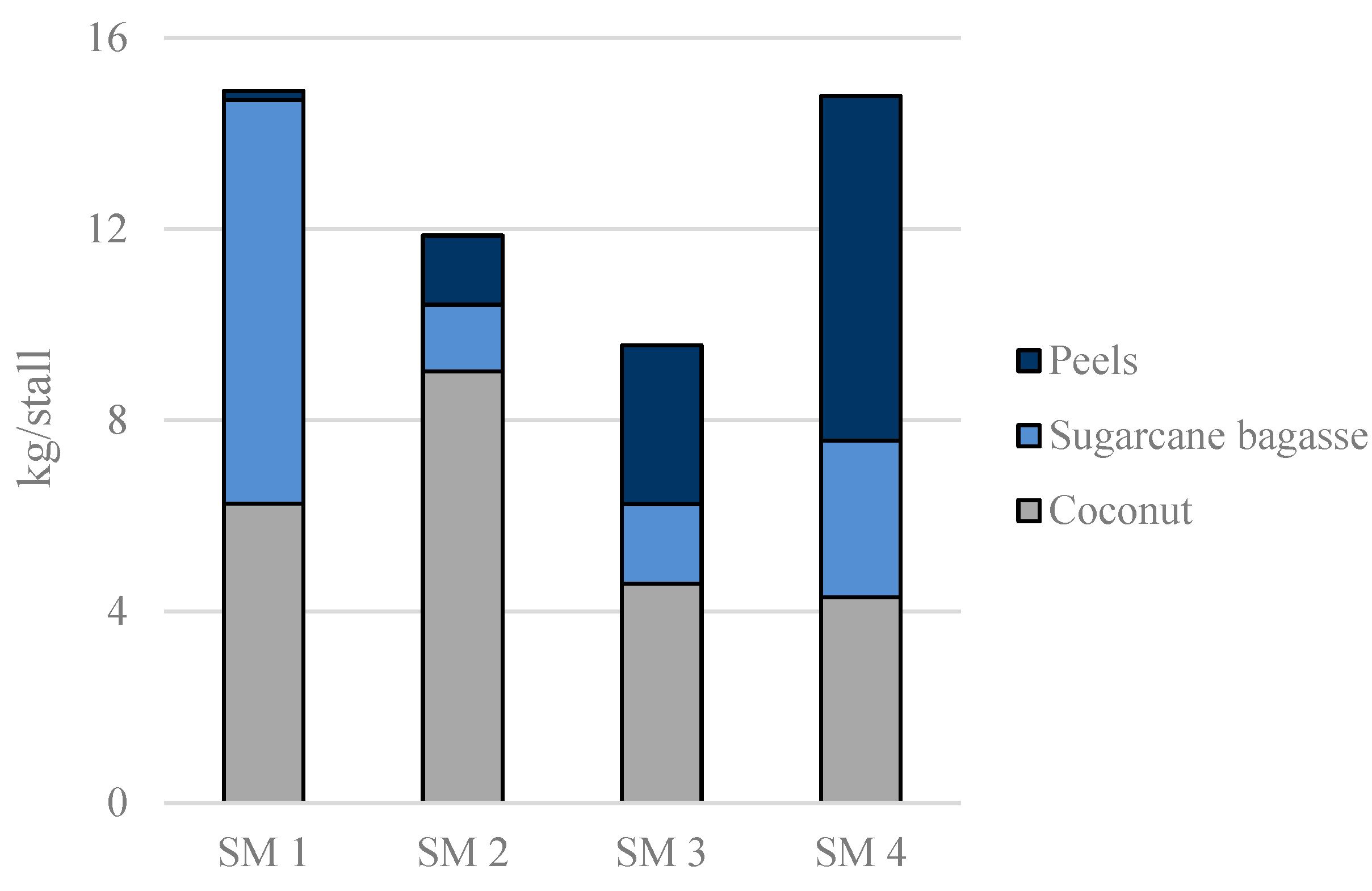Compositional Analysis of Street Market Food Waste in Brazil
Abstract
:1. Introduction
2. Materials and Methods
2.1. Waste Fractions
2.2. Study Area
2.3. Waste Sampling and Sorting Procedure
2.4. Data Analysis
3. Results and Discussion
3.1. Food Waste Composition and Generation Rate
3.2. Data Extrapolation to City Level
3.3. Limitations
4. Conclusions
Author Contributions
Funding
Data Availability Statement
Acknowledgments
Conflicts of Interest
References
- Springmann, M.; Clark, M.; Mason-D’Croz, D.; Wiebe, K.; Bodirsky, B.L.; Lassaletta, L.; De Vries, W.; Vermeulen, S.J.; Herrero, M.; Carlson, K.M. Options for keeping the food system within environmental limits. Nature 2018, 562, 519–525. [Google Scholar] [CrossRef]
- FAO. The State of Food and Agriculture 2019: Moving forward on Food Loss and Waste Reduction; Food and Agriculture Organization of the United Nations: Rome, Italy, 2019. [Google Scholar]
- UNEP. Food Waste Index-Report 2021; UNEP: Nairobi, Kenya, 2021. [Google Scholar]
- Mbow, C.; Rosenzweig, C.; Barioni, L.G.; Benton, T.G.; Herrero, M.; Krishnapillai, M.; Liwenga, E.; Pradhan, P.; Rivera-Ferre, M.G.; Sapkota, T.; et al. Food Security. In Climate Change and Land: An IPCC Special Report on Climate Change, Desertification, Land Degradation, Sustainable Land Management, Food Security, and Greenhouse Gas Fluxes in Terrestrial Ecosystems; Shukla, P.R., Skeg, J., Buendia, E.C., Masson-Delmotte, V., Pörtner, H.-O., Roberts, D.C., Zhai, P., Slade, R., Conners, S., van Diemen, R.M., et al., Eds.; 2019; Available online: https://philpapers.org/rec/SHUCCA-2 (accessed on 1 June 2022).
- ABRELPE. Panorama 2021 dos Resíduos Sólidos no Brasil; ABRELPE: São Paulo, Brazil, 2021. [Google Scholar]
- Henz, G.P.; Porpino, G. Food losses and waste: How Brazil is facing this global challenge? Hortic. Bras. 2017, 35, 472–482. [Google Scholar] [CrossRef] [Green Version]
- Corrado, S.; Caldeira, C.; Eriksson, M.; Hanssen, O.J.; Hauser, H.-E.; van Holsteijn, F.; Liu, G.; Östergren, K.; Parry, A.; Secondi, L.; et al. Food waste accounting methodologies: Challenges, opportunities, and further advancements. Glob. Food Sec. 2019, 20, 93–100. [Google Scholar] [CrossRef]
- Caldeira, C.; De Laurentiis, V.; Corrado, S.; van Holsteijn, F.; Sala, S. Quantification of food waste per product group along the food supply chain in the European Union: A mass flow analysis. Resour. Conserv. Recycl. 2019, 149, 479–488. [Google Scholar] [CrossRef]
- Brancoli, P.; Lundin, M.; Bolton, K.; Eriksson, M. Bread loss rates at the supplier-retailer interface–Analysis of risk factors to support waste prevention measures. Resour. Conserv. Recycl. 2019, 147, 128–136. [Google Scholar] [CrossRef]
- Brancoli, P.; Bolton, K.; Eriksson, M. Environmental impacts of waste management and valorisation pathways for surplus bread in Sweden. Waste Manag. 2020, 117, 136–145. [Google Scholar] [CrossRef]
- Xue, L.; Liu, G.; Parfitt, J.; Liu, X.; Van Herpen, E.; Stenmarck, Å.; O’Connor, C.; Östergren, K.; Cheng, S. Missing Food, Missing Data? A Critical Review of Global Food Losses and Food Waste Data. Environ. Sci. Technol. 2017, 51, 6618–6633. [Google Scholar] [CrossRef] [PubMed]
- Withanage, S.V.; Dias, G.M.; Habib, K. Review of household food waste quantification methods: Focus on composition analysis. J. Clean. Prod. 2021, 279, 123722. [Google Scholar] [CrossRef]
- Edjabou, M.E.; Boldrin, A.; Astrup, T.F. Compositional analysis of seasonal variation in Danish residual household waste. Resour. Conserv. Recycl. 2018, 130, 70–79. [Google Scholar] [CrossRef] [Green Version]
- Parry, A. Measuring Household Food Waste–The UK Experience, Meeting of the EU Platform on Food Losses and Food Waste. Available online: https://ec.europa.eu/food/sites/food/files/safety/docs/fw_eu-platform_20170331_wrap-measuring.pdf (accessed on 22 November 2017).
- Rousta, K.; Bolton, K.; Lundin, M.; Dahlén, L. Quantitative assessment of distance to collection point and improved sorting information on source separation of household waste. Waste Manag. 2015, 40, 22–30. [Google Scholar] [CrossRef]
- Malamis, D.; Moustakas, K.; Bourka, A.; Valta, K.; Papadaskalopoulou, C.; Panaretou, V.; Skiadi, O.; Sotiropoulos, A. Compositional analysis of biowaste from study sites in Greek municipalities. Waste Biomass Valorization 2015, 6, 637–646. [Google Scholar] [CrossRef]
- Brancoli, P.; Rousta, K.; Bolton, K. Life cycle assessment of supermarket food waste. Resour. Conserv. Recycl. 2017, 118, 39–46. [Google Scholar] [CrossRef]
- Eriksson, M.; Strid, I.; Hansson, P.-A. Food losses in six Swedish retail stores: Wastage of fruit and vegetables in relation to quantities delivered. Resour. Conserv. Recycl. 2012, 68, 14–20. [Google Scholar] [CrossRef]
- Cicatiello, C.; Franco, S.; Pancino, B.; Blasi, E.; Falasconi, L. The dark side of retail food waste: Evidences from in-store data. Resour. Conserv. Recycl. 2017, 125, 273–281. [Google Scholar] [CrossRef]
- Scherhaufer, S.; Schneider, F. Prevention, recycling and disposal of waste bread in Austria. In Proceedings of the Thirteenth International Landfill Symposium, Cagliari, Italy, 3 October 2011. [Google Scholar]
- Lebersorger, S.; Schneider, F. Food loss rates at the food retail, influencing factors and reasons as a basis for waste prevention measures. Waste Manag. 2014, 34, 1911–1919. [Google Scholar] [CrossRef]
- Costa, F.H.d.O.; de Moraes, C.C.; da Silva, A.L.; Delai, I.; Chaudhuri, A.; Pereira, C.R. Does resilience reduce food waste? Analysis of Brazilian supplier-retailer dyad. J. Clean. Prod. 2022, 338, 130488. [Google Scholar] [CrossRef]
- de Brito Nogueira, T.B.; da Silva, T.P.M.; de Araújo Luiz, D.; de Andrade, C.J.; de Andrade, L.M.; Ferreira, M.S.L.; Fai, A.E.C. Fruits and vegetable-processing waste: A case study in two markets at Rio de Janeiro, RJ, Brazil. Environ. Sci. Pollut. Res. 2020, 27, 18530–18540. [Google Scholar] [CrossRef]
- Dos Santos, S.F.; Cardoso, R.d.C.V.; Borges, Í.M.P.; Almeida, A.C.e.; Andrade, E.S.; Ferreira, I.O.; Ramos, L.d.C. Post-harvest losses of fruits and vegetables in supply centers in Salvador, Brazil: Analysis of determinants, volumes and reduction strategies. Waste Manag. 2020, 101, 161–170. [Google Scholar] [CrossRef]
- Lana, M.M.; Moita, A.W. Qualidade visual e desperdício de hortaliças e ervas frescas em um típico mercado varejista no Brasil. Hortic. Bras. 2019, 37, 161–171. [Google Scholar] [CrossRef] [Green Version]
- De Segurança Alimentar, C.I. Estratégia Intersetorial Para a Redução de Perdas e Desperdício de Alimentos no Brasil. 2018. Available online: https://nutricao.t4h.com.br/manuais/estrategia-intersetorial-para-a-reducao-de-perdas-e-desperdicio-de-alimentos-no-brasil/ (accessed on 2 August 2021).
- Mascarenhas, G.; Dolzani, M.C.S. Feira livre: Territorialidade popular e cultura na metrópole contemporânea. Ateliê Geogr. 2008, 2, 72–87. [Google Scholar] [CrossRef]
- Freitas, K.A. Mobilidade Urbana e Hábitos de Compra: Efeitos na Distribuição e na Logística Para o Varejo; Universidade Federal de Minas Gerais: Belo Horizonte, Brazil, 2015. [Google Scholar]
- Fehr, M.; Romão, D.C. Measurement of fruit and vegetable losses in Brazil: A case study. Environ. Dev. Sustain. 2001, 3, 253–263. [Google Scholar] [CrossRef]
- Liikanen, M.; Havukainen, J.; Viana, E.; Horttanainen, M. Steps towards more environmentally sustainable municipal solid waste management–A life cycle assessment study of São Paulo, Brazil. J. Clean. Prod. 2018, 196, 150–162. [Google Scholar] [CrossRef]
- Prefeitura de São Paulo Resíduos Orgânicos-Compostagem em São Paulo. Available online: https://www.prefeitura.sp.gov.br/cidade/secretarias/subprefeituras/amlurb/index.php?p=283430 (accessed on 2 August 2021).
- Edjabou, M.E.; Jensen, M.B.; Götze, R.; Pivnenko, K.; Petersen, C.; Scheutz, C.; Astrup, T.F. Municipal solid waste composition: Sampling methodology, statistical analyses, and case study evaluation. Waste Manag. 2015, 36, 12–23. [Google Scholar] [CrossRef] [PubMed] [Green Version]
- Östergren, K.; Bos-Brouwers, H.E.J.; Timmermans, A.J.M.; Soethoudt, J.M.; Gustavsson, J.; Hansen, O.J.; Möller, H.; Anderson, G.; O’Connor, C.; Quested, T. FUSIONS Definitional Framework for Food Waste; FUSIONS N FP7-KBBE-2012-6-311972: Gothenburg, Sweden, 2014. [Google Scholar]
- WRAP. Household Food and Drink Waste in the UK; WRAP: London, UK, 2009. [Google Scholar]
- Quested, T.; Ingle, R.; Parry, A. Household Food and Drink Waste in the United Kingdom 2012; WRAP: London, UK, 2013. [Google Scholar]
- Bernstad Saraiva Schott, A.; Andersson, T. Food waste minimization from a life-cycle perspective. J. Environ. Manag. 2015, 147, 219–226. [Google Scholar] [CrossRef]
- Pennington, J.A.T.; Fisher, R.A. Classification of fruits and vegetables. J. Food Compos. Anal. 2009, 22, S23–S31. [Google Scholar] [CrossRef]
- Thompson, F.E.; Willis, G.B.; Thompson, O.M.; Yaroch, A.L. The meaning of ‘fruits’ and ‘vegetables’. Public Health Nutr. 2011, 14, 1222–1228. [Google Scholar] [CrossRef] [Green Version]
- Instituto Brasileiro de Geografia e Estatística–IBGE. Pesquisa de Orçamentos Familiares 2017–2018: Análise do Consumo Alimentar Pessoal no Brasil; Instituto Rio de Janeiro: Rio de Janeiro, Brazil, 2020. [Google Scholar]
- Prefeitura de São Paulo Lista Completa de Feiras. Available online: https://www9.prefeitura.sp.gov.br/secretarias/sdte/pesquisa/feiras/lista_completa.htm (accessed on 9 January 2020).
- Mainville, D.Y. The Structure of Fresh Produce Markets in São Paulo: Recent Developments, Trends and Implications for Market Structure; Congresso Brasileiro de Economia e Sociologia Rural: Brasília, Brazil, 2002. [Google Scholar]
- Prefeitura de São Paulo Varrição de Ruas e Limpeza Pública. Available online: https://www.prefeitura.sp.gov.br/cidade/secretarias/spregula/limpeza_urbana/fiscalizacao/index.php?p=4638 (accessed on 20 February 2022).
- URBIT. IDH dos Bairros de São Paulo-SP. Available online: http://urbit.com.br/mapa/idh-sp (accessed on 23 December 2021).
- Hanson, C.; Lipinski, B.; Robertson, K.; Dias, D.; Gavilan, I.; Gréverath, P.; Ritter, S.; Fonseca, J.; Van Otterdijk, R.; Timmermans, T. Food Loss and Waste Accounting and Reporting Standard. WRI, Nestlé, CGF, FAO, EU-funded FUSIONS Project, UNEP, WRAP, WBCSD, NRI. URL. 2016. Available online: https://www.wri.org/research/food-loss-and-waste-accounting-and-reporting-standard (accessed on 1 June 2022).
- Lana, M.M.; Moita, A.W. Qualidade Visual e Perdas pós-Colheita de Hortaliças Folhosas no Varejo: Dois Estudos de Caso no Distrito Federal, Brasil; Embrapa Hortaliças-Documentos (INFOTECA-E): Brasília, Brazil, 2020. [Google Scholar]
- Kasso, M.; Bekele, A. Post-harvest loss and quality deterioration of horticultural crops in Dire Dawa Region, Ethiopia. J. Saudi Soc. Agric. Sci. 2018, 17, 88–96. [Google Scholar] [CrossRef] [Green Version]
- Chitarra, M.I.F.; Chitarra, A.B. Pós-Colheita de Frutos e Hortaliças: Fisiologia e Manuseio; Esal/Faepe: Lavras, Brazil, 1990. [Google Scholar]
- Li, Z.; Andrews, J.; Wang, Y. Mathematical modelling of mechanical damage to tomato fruits. Postharvest Biol. Technol. 2017, 126, 50–56. [Google Scholar] [CrossRef]
- Tuomela, M.; Vikman, M.; Hatakka, A.; Itävaara, M. Biodegradation of lignin in a compost environment: A review. Bioresour. Technol. 2000, 72, 169–183. [Google Scholar] [CrossRef]
- Gabhane, J.; William, S.P.M.P.; Bidyadhar, R.; Bhilawe, P.; Anand, D.; Vaidya, A.N.; Wate, S.R. Additives aided composting of green waste: Effects on organic matter degradation, compost maturity, and quality of the finished compost. Bioresour. Technol. 2012, 114, 382–388. [Google Scholar] [CrossRef]
- Teixeira, D.L.; de Matos, A.T.; de Castro Melo, E. Resistance to forced airflow through layers of composting organic material. Waste Manag. 2015, 36, 57–62. [Google Scholar] [CrossRef] [PubMed]
- Mohee, R.; Boojhawon, A.; Sewhoo, B.; Rungasamy, S.; Somaroo, G.D.; Mudhoo, A. Assessing the potential of coal ash and bagasse ash as inorganic amendments during composting of municipal solid wastes. J. Environ. Manag. 2015, 159, 209–217. [Google Scholar] [CrossRef] [PubMed]
- Cole, A.J.; Roberts, D.A.; Garside, A.L.; de Nys, R.; Paul, N.A. Seaweed compost for agricultural crop production. J. Appl. Phycol. 2016, 28, 629–642. [Google Scholar] [CrossRef]
- Kumar, R.; Verma, D.; Singh, B.L.; Kumar, U. Composting of sugar-cane waste by-products through treatment with microorganisms and subsequent vermicomposting. Bioresour. Technol. 2010, 101, 6707–6711. [Google Scholar] [CrossRef]
- Dahlén, L.; Lagerkvist, A. Methods for household waste composition studies. Waste Manag. 2008, 28, 1100–1112. [Google Scholar] [CrossRef]



| Fractions Level 0 | Fractions Level I | Fractions Level II | Description |
|---|---|---|---|
| Packaging | Packaging | Packaging | Plastic, wood, straw, paper, and cardboard. |
| Avoidable food waste | Leaves, flowers, and stems | Broccoli and cauliflower | |
| Cabbage | |||
| Other | e.g., lettuce, spinach, parsley, coriander, and stems. | ||
| Processed products | Tubers, bulbs, and roots | Products that are processed, e.g., peeled and cut, and are often sold in plastic trays. | |
| Fruits and vegetables | |||
| Leaves, flowers, and stems | |||
| Tubers, bulbs, and roots | Potato | ||
| Carrot | |||
| Onion | |||
| Other | e.g., garlic, beet, yam, cassava, turnip, and radish | ||
| Vegetables | Tomato | It includes botanically classified fruits that are culinarily classified as vegetables, and seeds. | |
| Pumpkin | |||
| Bell pepper | |||
| Chayote | |||
| Other | e.g., zucchini, eggplant, cucumber, peppers, okra. | ||
| Fruits | Banana | ||
| Orange | |||
| Watermelon | |||
| Papaya | |||
| Other | e.g., avocado, pineapple, peach, kiwi, lemon, mango, melon, strawberry. | ||
| Meat | Meat | Beef, pork, chicken, seafood, etc. | |
| Unavoidable food waste | Unavoidable food waste | Coconut | |
| Sugarcane bagasse | |||
| Peels | |||
| External waste | External waste | External waste | Fractions that are not produced in the street market, but are collected together. |
| Street Market | Name | Day of the Week | District | HDI | Number of Stalls | Total Waste Collected (kg) |
|---|---|---|---|---|---|---|
| SM 1 | Parque da Mooca | Tuesday | Parque da Mooca | 0.819 | 4 | 74.2 |
| SM 2 | Sumaré Moderna | Tuesday | Pacaembú | 0.868 | 73 | 1523.7 |
| SM 3 | Baturité | Wednesday | Aclimação | 0.823 | 40 | 1033.9 |
| SM 4 | Belém | Thursday | Belenzinho | 0.790 | 39 | 1483.5 |
| Fractions (Level II) | SM 1 | SM 2 | SM 3 | SM 4 |
|---|---|---|---|---|
| Packaging | ||||
| Packaging | 2.00 | 3.07 | 3.40 | 5.89 |
| Leaves, flowers, and stems | ||||
| Broccoli and cauliflower | 0.00 | 0.00 | 0.03 | 0.17 |
| Cabbage | 0.00 | 0.01 | 0.00 | 0.00 |
| Other | 0.00 | 1.17 | 6.80 | 7.55 |
| Processed products | ||||
| Tubers, bulbs, and roots | 0.00 | 0.00 | 0.01 | 0.00 |
| Fruits and vegetables | 0.00 | 0.00 | 0.00 | 0.00 |
| Leaves, flowers, and stems | 0.00 | 0.00 | 0.00 | 0.00 |
| Tubers, bulbs, and roots | ||||
| Potato | 0.00 | 0.02 | 0.02 | 0.36 |
| Carrot | 0.00 | 0.00 | 0.02 | 0.07 |
| Onion | 0.00 | 0.00 | 0.04 | 0.26 |
| Other | 0.00 | 0.00 | 0.00 | 0.16 |
| Vegetables | ||||
| Tomato | 0.11 | 0.05 | 0.24 | 1.22 |
| Pumpkin | 0.00 | 0.03 | 0.00 | 0.02 |
| Bell pepper | 0.00 | 0.00 | 0.00 | 0.00 |
| Chayote | 0.00 | 0.00 | 0.00 | 0.00 |
| Other | 0.00 | 0.33 | 0.10 | 0.29 |
| Fruits | ||||
| Banana | 0.00 | 0.01 | 0.40 | 0.22 |
| Orange | 0.00 | 0.19 | 0.24 | 0.53 |
| Watermelon | 0.00 | 0.01 | 0.22 | 0.00 |
| Papaya | 0.00 | 0.03 | 0.09 | 0.07 |
| Other | 0.00 | 0.11 | 0.58 | 2.89 |
| Unavoidable food waste | ||||
| Coconut | 6.26 | 9.02 | 4.59 | 4.30 |
| Sugarcane bagasse | 8.44 | 1.40 | 1.66 | 3.27 |
| Peels | 0.19 | 1.45 | 3.32 | 7.21 |
| Meat | ||||
| Meat | 0.00 | 3.41 | 1.35 | 0.07 |
| External waste | ||||
| External waste | 1.56 | 0.57 | 2.74 | 3.49 |
| Variable | Unit | Mass Per Stall |
|---|---|---|
| Mean | kg | 23.7 |
| SE Mean a | kg | 3.8 |
| StDev b | kg | 7.6 |
| CoefVar c | 32.1 | |
| Minimum | kg | 17.0 |
| Q1 d | kg | 17.8 |
| Median | kg | 21.7 |
| Q3 e | kg | 31.7 |
Publisher’s Note: MDPI stays neutral with regard to jurisdictional claims in published maps and institutional affiliations. |
© 2022 by the authors. Licensee MDPI, Basel, Switzerland. This article is an open access article distributed under the terms and conditions of the Creative Commons Attribution (CC BY) license (https://creativecommons.org/licenses/by/4.0/).
Share and Cite
Brancoli, P.; Makishi, F.; Lima, P.G.; Rousta, K. Compositional Analysis of Street Market Food Waste in Brazil. Sustainability 2022, 14, 7014. https://doi.org/10.3390/su14127014
Brancoli P, Makishi F, Lima PG, Rousta K. Compositional Analysis of Street Market Food Waste in Brazil. Sustainability. 2022; 14(12):7014. https://doi.org/10.3390/su14127014
Chicago/Turabian StyleBrancoli, Pedro, Fausto Makishi, Paula Garcia Lima, and Kamran Rousta. 2022. "Compositional Analysis of Street Market Food Waste in Brazil" Sustainability 14, no. 12: 7014. https://doi.org/10.3390/su14127014
APA StyleBrancoli, P., Makishi, F., Lima, P. G., & Rousta, K. (2022). Compositional Analysis of Street Market Food Waste in Brazil. Sustainability, 14(12), 7014. https://doi.org/10.3390/su14127014







